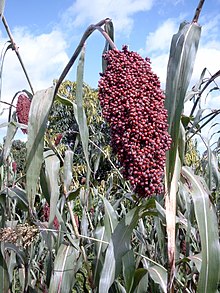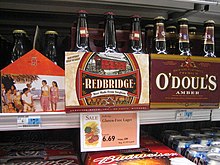Gluten free beer
Gluten-free beer is the name for beer types that do not contain the protein mixture gluten contained in wheat , rye or barley or its constituents gliadin or glutenin, or only in very small quantities. They are therefore suitable for consumption by people with gluten intolerance (celiac disease). For the production of gluten-free beer, in addition to using gluten-free types of grain as starting materials for the brewing process , the use of conventional types of grain is also possible, provided that the gluten is removed from the end product using technological processes. Due to the higher technical and organizational effort involved in production and the small sales market, gluten-free beers are generally significantly more expensive than conventional types.
Manufacturing

According to EU guidelines, beers and other foods are considered gluten-free if they contain less than 20 mg / kg gluten. Beers made from gluten-free ingredients are absolutely gluten-free. Starting materials for the production of such beers and beer-like beverages are gluten-free types of grain, such as corn , rice or various types of millet , and pseudo -grain types such as buckwheat , amaranth or quinoa . In some cases, malt mixtures made from several of these raw materials are also used. Traditionally prepared beers or beer-like drinks based on these types are widespread in various regions of the world, such as Japanese sake made from rice, chicha made from corn in South America or the millet-based drinks Tella , Dolo and Merisa in Africa . However, industrially produced gluten-free beer is produced using modern brewing processes and the taste is often based on commercially available beers.
Other technologically possible manufacturing processes for the production of gluten-free beer are the enzymatic breakdown of gluten during the production process, as well as the cultivation of gluten-free varieties of the types of grain commonly used for brewing beer or their development using genetic engineering methods. Gluten-free beer-like beverages can also be produced by using honey , syrup and similar sugary raw materials for the fermentation process as well as the use of flavorings and foam-forming substances.
When using barley malt and subsequently removing gluten, beer with a low gluten content can be brewed. A beer declared as gluten-free on this basis has been available in Germany since 2008 . With this type of beer, the gluten contained in the barley is removed using a special process after the brewing process. Residual traces of gluten, below the limit value of 20 mg / kg, may still be present.
economic aspects
Due to the small market and the complex production process, gluten-free beers are significantly more expensive than beer based on the common types of grain. Prerequisites are, for example, the exclusive use of a brewery plant only for the production of gluten-free beer and ensuring the strict separation of gluten-free ingredients from gluten-containing raw materials during transport, storage and processing. It is not possible to alternate the operation of the same system for gluten-containing or gluten-free varieties as required, since even the smallest traces of gluten can lead to severe symptoms in the case of sensitive celiac patients.
For the reasons mentioned, gluten-free beer is mainly produced by smaller breweries and companies that specialize in using gluten-free ingredients. It is mainly available in health food stores and health food stores.
literature
- Marion Zarkadas, Shelley Case: Celiac Disease and the Gluten-Free Diet. An overview. In: Topics in Clinical Nutrition. Vol. 20, No. 2, 2005, ISSN 0883-5691 , pp. 127-138.
- Martin Zarnkow, Stefan Kreisz, Werner Back: Gluten-free beers. Different manufacturing processes in focus. In: Brewing Industry. Vol. 90, No. 7, 2005, ISSN 0341-7115 , pp. 26-28 .
- Michael J. Lewis: Celiac Disease, Beer, and Brewing. In: MBAA Technical Quarterly. Vol. 42, No. 1, 2005, ISSN 0743-9407 , pp. 45-48.
Individual evidence
- ↑ Regulation (EC) No. 41/2009 , accessed on July 2, 2014
- ^ A b c Ludwig Narziss , Werner Back, Martina Gastl , Martin Zarnkow: The top fermentation . In: Demolition of the brewery . 8th edition. Wiley-VCH Verlag , Weinheim 2017, ISBN 978-3-527-81282-0 , pp. 441-443 , doi : 10.1002 / 9783527812820.ch8 .

